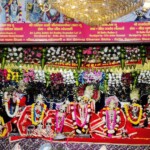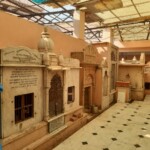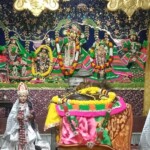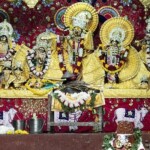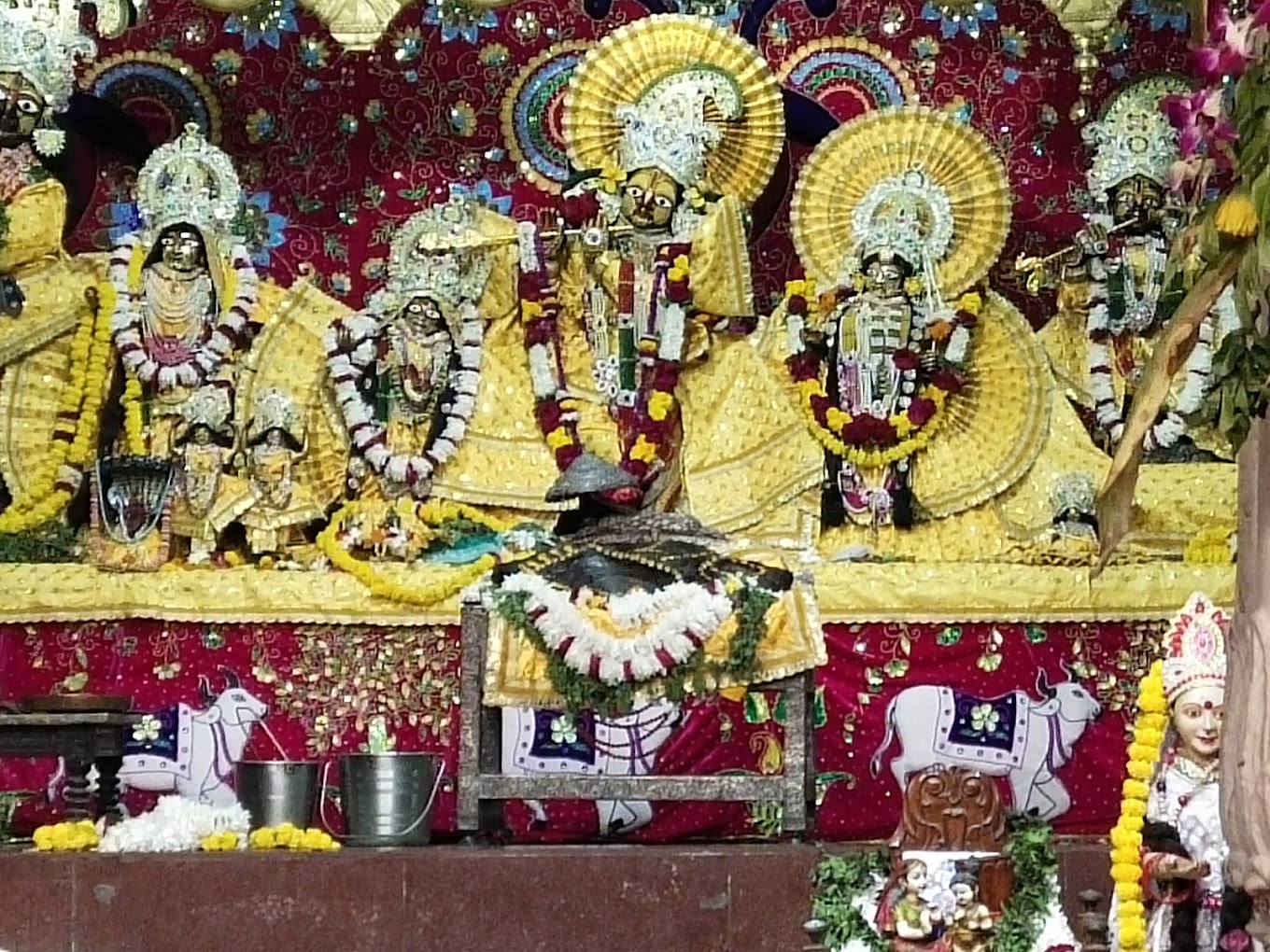
Nestled in the sacred town of Vrindavan, the Radha Damodar Temple stands as a timeless testament to devotion and spirituality. This article will delve into the rich history, visiting timings, entry fees, the divine experience of Aarti, and the best time to embark on a spiritual journey to this celestial abode.
Radha Damodar Temple Vrindavan Timings
| Day | Timing |
|---|---|
| Monday | Winter: 8:00 am to 12:00 pm - 5:00 pm to 8.30 pm Summer: 7:00 am to 12.30 pm - 4:00 pm to 9.30 pm |
| Tuesday | Winter: 8:00 am to 12:00 pm - 5:00 pm to 8.30 pm Summer: 7:00 am to 12.30 pm - 4:00 pm to 9.30 pm |
| Wednesday | Winter: 8:00 am to 12:00 pm - 5:00 pm to 8.30 pm Summer: 7:00 am to 12.30 pm - 4:00 pm to 9.30 pm |
| Thursday | Winter: 8:00 am to 12:00 pm - 5:00 pm to 8.30 pm Summer: 7:00 am to 12.30 pm - 4:00 pm to 9.30 pm |
| Friday | Winter: 8:00 am to 12:00 pm - 5:00 pm to 8.30 pm Summer: 7:00 am to 12.30 pm - 4:00 pm to 9.30 pm |
| Saturday | Winter: 8:00 am to 12:00 pm - 5:00 pm to 8.30 pm Summer: 7:00 am to 12.30 pm - 4:00 pm to 9.30 pm |
| Sunday | Winter: 8:00 am to 12:00 pm - 5:00 pm to 8.30 pm Summer: 7:00 am to 12.30 pm - 4:00 pm to 9.30 pm |
History Radha Damodar Temple Vrindavan, Mathura, Uttar Pradesh
The Radha Damodar Temple was founded in the year 1542 by Shri Jiva Goswami, one of the principal disciples of Shri Chaitanya Mahaprabhu. Shri Jiva Goswami dedicated his life to preserving the teachings and traditions of Lord Chaitanya, and he chose Vrindavan as the place to establish this sacred temple.
The temple is dedicated to Lord Krishna, specifically in His form as Damodar. Lord Damodar is one of the endearing childhood forms of Lord Krishna, depicting Him as a mischievous child who was bound by His mother, Yashoda, with a rope (damala) around His waist (udara). This form of Krishna symbolizes the divine playfulness and charm that captivates devotees.
The Legend of Shri Jiva Goswami
Shri Jiva Goswami, one of the principal disciples of Shri Chaitanya Mahaprabhu, was entrusted with the task of preserving the teachings and traditions of Lord Chaitanya. He chose Vrindavan as the sacred place to fulfill this divine mission, and thus, the Radha Damodar Temple was born.
Timings for Radha Damodar Temple
Before planning your visit to this holy place, it’s essential to know the temple’s timings. The Radha Damodar Temple opens its doors to seekers of the divine from 7:00 AM to 12:30 PM and then reopens in the evening from 4:00 PM to 9:30 PM.
Exploring the Sanctum
Visitors to the temple can witness the enchanting deity of Lord Damodar, a captivating form of Lord Krishna. The deity is exquisitely adorned with intricate jewelry and colorful garments, attracting devotees from all corners of the world.
The Divine Aarti
One of the most enchanting experiences at Radha Damodar Temple is witnessing the divine Aarti. The evening Aarti, which takes place around 7:00 PM, is a spectacle of devotion and spirituality. The temple resonates with melodious bhajans, incense fills the air, and the rhythmic clanging of bells creates an ambiance that transports you to a higher realm.
Radha Damodar Temple Vrindavan Entry Fee
To enter this sacred temple, there is no entry fee as spirituality knows no monetary boundaries. Devotees are welcomed with open arms, irrespective of their background or financial status.
Image Gallery of Radha Damodar Temple Vrindavan
Architecture of Radha Damodar Temple Vrindavan
The architecture of the Radha Damodar Temple in Vrindavan is a magnificent example of traditional Hindu temple architecture, reflecting the timeless devotion and craftsmanship that went into its construction. This temple, dedicated to Lord Krishna in His form as Damodar, stands as a testament to the rich cultural heritage of India.
Here’s a closer look at the architectural features of this spiritual masterpiece:
1. Temple Layout: The Radha Damodar Temple follows a traditional temple layout commonly seen in North India. It consists of a central sanctum sanctorum (garbhagriha), a mandapa (hall), and an outer courtyard. This layout is designed to guide devotees through a ritualistic and spiritual journey.
2. Sculptures and Carvings: The temple is adorned with intricate stone carvings and sculptures that depict various episodes from Lord Krishna’s life. These sculptures are not only aesthetically pleasing but also serve as a means to educate and inspire devotees about the divine pastimes of Lord Krishna.
3. Towering Shikhara: The temple features a prominent shikhara (spire) above the sanctum sanctorum. This shikhara is often adorned with intricate motifs and sculptures of deities and celestial beings. The height and grandeur of the shikhara symbolize the majesty and divinity of Lord Krishna.
4. Ornate Temple Gateway: As you approach the Radha Damodar Temple, you’ll pass through an ornate temple gateway, known as the gopuram. The gopuram typically features impressive architectural details, including intricate carvings, friezes, and figures of deities. It serves as a transition point from the outside world into the sacred temple space.
5. Courtyard and Open Space: The temple complex often includes a spacious courtyard where devotees can gather, meditate, and participate in religious ceremonies. The open space allows for a sense of community and spiritual camaraderie among worshippers.
6. Decorative Elements: The Radha Damodar Temple is known for its elaborate decorative elements. These include finely detailed doorways, pillars, and ceilings adorned with delicate artwork. Floral patterns, geometric designs, and depictions of celestial beings are commonly featured in the temple’s interior and exterior decorations.
7. Altar and Deity Chamber: The heart of the temple is the sanctum sanctorum, where the main deity, Lord Damodar, is enshrined. The altar is beautifully decorated with garlands, flowers, and lamps during daily worship rituals. Devotees offer their prayers and seek blessings in front of the deity.
8. Use of Marble and Stone: Traditional materials like marble and stone are often used in the construction of the Radha Damodar Temple. These materials not only add to the temple’s aesthetic appeal but also ensure the longevity of the structure.
The Radha Damodar Temple in Vrindavan showcases a stunning blend of art, devotion, and architecture. Its intricate carvings, towering spire, and ornate details make it a revered place of worship and a visual delight for all who visit. The temple’s architecture serves as a conduit for spiritual experiences, allowing devotees to connect with the divine in a serene and sacred environment.
The Best Time to Visit Radha Damodar Temple Vrindavan
The Radha Damodar Temple in Vrindavan is a sacred place of worship and spirituality that attracts devotees from all over the world. To make the most of your visit and experience the temple’s divine ambiance, it’s essential to choose the best time to plan your trip. Here’s a detailed guide on when to visit the Radha Damodar Temple:
1. October to March (Winter Months):
- Best Time: The period from October to March is considered the best time to visit the Radha Damodar Temple. These months mark the winter season in Vrindavan, and the weather is pleasant and comfortable for outdoor activities and temple visits.
- Weather: During this time, the weather is relatively cool and dry, with daytime temperatures ranging from 15°C to 25°C (59°F to 77°F). The evenings can be slightly cooler, so carrying a light sweater or shawl is advisable.
- Festivals: Vrindavan comes alive with various festivals during this season, including Diwali, Holi, and Janmashtami. Witnessing these vibrant celebrations adds a unique cultural dimension to your visit.
- Spiritual Significance: The winter months are traditionally associated with many significant events in Lord Krishna’s life, making it an auspicious time for devotees. It’s also a time when you can participate in various spiritual activities and gatherings.
2. Kartik Month (October/November):
- Special Mention: The month of Kartik, which usually falls in October or November, is of particular significance for devotees. It’s a spiritually charged month dedicated to Lord Krishna. The Radha Damodar Temple and Vrindavan, in general, come alive with heightened devotion, daily Aartis, and colorful processions. If you want to experience the epitome of devotion, consider planning your visit during Kartik.
3. Avoiding Peak Summer (April to June):
- Caution: It’s advisable to avoid visiting during the peak summer months of April to June. During this period, Vrindavan experiences scorching temperatures that can exceed 40°C (104°F). The extreme heat can make outdoor activities, including temple visits, uncomfortable.
4. Monsoon Months (July to September):
- Consideration: While some travelers may enjoy the lush greenery that the monsoon season brings to Vrindavan, it’s essential to be cautious. Heavy rainfall can disrupt travel plans, and the temple premises may become slippery and challenging to navigate.
The best time to visit the Radha Damodar Temple in Vrindavan is during the winter months, from October to March. This period offers pleasant weather, vibrant festivals, and a spiritually charged atmosphere. Additionally, the auspicious month of Kartik is a special time for devotees to immerse themselves in devotion and experience the temple’s divine aura at its peak.
How to Reach Radha Damodar Temple?
Reaching the Radha Damodar Temple in Vrindavan is relatively easy due to the town’s popularity as a pilgrimage destination. Here are several ways to reach the temple:
1. By Air:
- Nearest Airport: The nearest major airport to Vrindavan is the Indira Gandhi International Airport in New Delhi, which is approximately 150 kilometers (about 93 miles) away. From the airport, you can hire a taxi or take a pre-booked cab to Vrindavan.
2. By Train:
- Vrindavan Railway Station: Vrindavan has a railway station, but it primarily caters to passenger trains. The nearest major railway station with good connectivity is the Mathura Junction, located about 14 kilometers (approximately 9 miles) from Vrindavan.
- Mathura Junction: From Mathura Junction, you can easily find auto-rickshaws or taxis to take you to Vrindavan. The journey typically takes around 30 minutes, depending on traffic conditions.
3. By Road:
- From Delhi: Vrindavan is well-connected by road to major cities like Delhi, Agra, and Jaipur. You can drive to Vrindavan from Delhi, which is approximately a 3-4 hour journey, depending on traffic.
- Bus Services: There are also bus services that connect Vrindavan to various cities in North India. You can check with local bus operators or use intercity bus services to reach Vrindavan.
4. Local Transportation in Vrindavan:
- Auto-Rickshaws: Once you reach Vrindavan, the most common mode of local transportation is auto-rickshaws. They are readily available and can take you to the Radha Damodar Temple and other places of interest in the town.
- Cycle Rickshaws: For shorter distances within Vrindavan, cycle rickshaws are a convenient and eco-friendly option. They can navigate through the narrow lanes of the town.
- Taxi Services: You can also hire taxis for more comfortable and private transportation within Vrindavan.
5. Navigation Tips:
- GPS and Maps: It’s a good idea to have a GPS-enabled device or smartphone with maps to navigate the town, especially if you plan to explore Vrindavan independently.
- Local Guidance: Locals in Vrindavan are usually friendly and willing to provide directions and assistance if needed. Don’t hesitate to ask for help if you’re unsure about the route.
- Temple Location: The Radha Damodar Temple is a prominent and well-known temple in Vrindavan. Most local residents and auto-rickshaw drivers will be familiar with its location.
Navigating to the Radha Damodar Temple in Vrindavan is a straightforward process, thanks to the town’s popularity among pilgrims and tourists. Whether you choose to travel by air, train, or road, you’ll find suitable options to reach this sacred destination.
Hotels near Radha Damodar Temple Vrindavan
Vrindavan is a place of spiritual significance and attracts pilgrims from all over the world. While it may not have an extensive range of luxury hotels, there are several comfortable accommodations near the Radha Damodar Temple that cater to the needs of visitors. Here are some hotels and guesthouses you can consider:
1. Nidhivan Sarovar Portico:
Location: Chatikara Road, Vrindavan (Approx. 3.5 kilometers from Radha Damodar Temple)
Description: This hotel offers comfortable rooms, a serene ambiance, and modern amenities. It’s known for its excellent hospitality.
2. Hotel Brijwasi Lands Inn:
Location: Sunrakh Road, Vrindavan (Approx. 2 kilometers from Radha Damodar Temple)
Description: This hotel provides a range of room options to suit different budgets. It also has a restaurant serving delicious vegetarian meals.
3. MVT Guesthouse and Restaurant:
Location: Loi Bazar, Vrindavan (Approx. 1.5 kilometers from Radha Damodar Temple)
Description: This guesthouse is known for its clean rooms, friendly staff, and an on-site vegetarian restaurant.
4. Hotel Krishna Orchid:
Location: Parikrama Marg, Vrindavan (Approx. 2.5 kilometers from Radha Damodar Temple)
Description: A budget-friendly option with basic amenities and a convenient location.
5. The Bhaktivedanta Hospice:
Location: Near the ISKCON Temple, Vrindavan (Approx. 4 kilometers from Radha Damodar Temple)
Description: This guesthouse is affiliated with the International Society for Krishna Consciousness (ISKCON) and offers a peaceful atmosphere.
6. Yashoda Dham Guesthouse:
Location: Near Prem Mandir, Vrindavan (Approx. 4.5 kilometers from Radha Damodar Temple)
Description: This guesthouse is close to the famous Prem Mandir and provides a serene stay experience.
7. MVT Guesthouse:
Location: Bhaktivedanta Swami Marg, Vrindavan (Approx. 3 kilometers from Radha Damodar Temple)
Description: Another branch of MVT Guesthouse is known for its tranquil environment and reasonable rates.
8. Hotel Santosh Dham:
Location: Near Banke Bihari Temple, Vrindavan (Approx. 3.5 kilometers from Radha Damodar Temple)
Description: A no-frills budget hotel offering a convenient location near the Banke Bihari Temple.
Please note that Vrindavan tends to get crowded during peak pilgrimage seasons, so it’s advisable to make hotel reservations in advance, especially if you plan to visit during major festivals or special events. These hotels and guesthouses provide a range of options to suit different budgets and preferences, allowing you to have a comfortable stay while exploring the spiritual beauty of Vrindavan.
Visiting Nearby Temples Radha Damodar Temple Vrindavan
When visiting the Radha Damodar Temple in Vrindavan, you’ll have the opportunity to explore several other nearby temples, each with its unique charm and significance in the town’s rich spiritual tapestry. Here are some of the prominent nearby temples to consider visiting:
1. Radharaman Temple:
- Distance from Radha Damodar Temple: Approximately 750 meters (less than a mile)
- Description: The Radharaman Temple is dedicated to Lord Krishna, and it’s renowned for its deity of Lord Radharaman, which is believed to have self-manifested from a sacred shaligram shila. The temple’s architecture and spiritual ambiance make it a must-visit for devotees.
2. Radha Vallabh Temple:
- Distance from Radha Damodar Temple: Approximately 1.5 kilometers (about 0.9 miles)
- Description: The Radha Vallabh Temple is a significant temple for followers of the Pushtimarg tradition. It’s dedicated to Lord Krishna and Radha, and the deities here are known for their playful and loving expressions.
3. Radha Gokulananda Temple:
- Distance from Radha Damodar Temple: Approximately 2 kilometers (about 1.2 miles)
- Description: This temple is dedicated to the divine couple, Radha and Krishna. It’s known for its intricate marble work and beautiful deities of Radha and Gokulananda. The temple’s serene environment encourages meditation and devotion.
4. Banke Bihari Temple:
- Distance from Radha Damodar Temple: Approximately 3.5 kilometers (about 2.2 miles)
- Description: The Banke Bihari Temple is one of the most popular and vibrant temples in Vrindavan. It’s dedicated to Lord Krishna, particularly in His childhood “Banke Bihari” form. The temple is known for its lively Aartis and devotional music.
5. Prem Mandir:
- Distance from Radha Damodar Temple: Approximately 4.5 kilometers (about 2.8 miles)
- Description: Prem Mandir, also known as the Temple of Love, is a relatively new but stunning temple in Vrindavan. It’s dedicated to Radha and Krishna and is known for its exquisite architecture, intricate marble work, and captivating light and sound shows in the evening.
6. Iskcon Temple (Krishna Balaram Mandir):
- Distance from Radha Damodar Temple: Approximately 3 kilometers (about 1.9 miles)
- Description: The Iskcon Temple, also known as the Krishna Balaram Mandir, is a significant temple complex dedicated to Lord Krishna and Lord Balaram. It’s associated with the International Society for Krishna Consciousness (ISKCON) and offers a serene spiritual atmosphere.
These nearby temples each offer a unique spiritual experience and provide a deeper understanding of the diverse devotional traditions that thrive in Vrindavan. Whether you’re seeking serene meditation, lively Aartis, or exquisite architecture, exploring these temples will enrich your spiritual journey in this sacred town.
Conclusion
The Radha Damodar Temple in Vrindavan is not just a place of worship; it’s a spiritual haven that connects devotees to the divine. With its rich history, enchanting Aarti, and the divine presence of Lord Damodar, it offers a profound experience that leaves a lasting impact on the soul.
Google Map for Radha Damodar Temple Vrindavan
FAQs about the Radha Damodar Temple in Vrindavan
Can anyone visit the Radha Damodar Temple, regardless of their faith or background?
Yes, the temple is open to people of all faiths and backgrounds. It promotes inclusivity and spiritual harmony.
What is the best time to visit the Radha Damodar Temple in Vrindavan?
The best time to visit is during the winter months, from October to March, when the weather is pleasant. The month of Kartik, usually in October or November, is also auspicious for a visit.
What can I expect during the evening Aarti at Radha Damodar Temple?
The evening Aarti is a mesmerizing experience with melodious bhajans, the fragrance of incense, and the rhythmic clanging of bells. It creates an ambiance that transports you to a higher spiritual realm.
Is there an entry fee to visit the Radha Damodar Temple?
No, there is no entry fee. The temple welcomes all devotees with open arms, and access is free.
Are there any specific dress code guidelines for visitors to the temple?
While there may not be strict dress code guidelines, it's advisable to dress modestly out of respect for the temple's spiritual environment. Avoid wearing revealing clothing when visiting.
Can I take photographs inside the temple premises?
Photography rules may vary, so it's best to check with the temple authorities or caretakers before taking photographs inside the temple. Some temples allow photography in designated areas.
Are there any specific rituals or practices that visitors should be aware of when visiting the Radha Damodar Temple?
While there are no specific rituals that visitors must perform, it's recommended to maintain a respectful and reverent demeanor. Many visitors offer prayers, bow, and chant mantras as acts of devotion.
Is there any accommodation available near the Radha Damodar Temple for devotees and tourists?
Yes, there are several hotels, guesthouses, and lodges in the vicinity of the Radha Damodar Temple that cater to the accommodation needs of visitors.
Are there any particular festivals or events celebrated at the Radha Damodar Temple throughout the year?
Yes, the temple celebrates various festivals, with Kartik month being particularly auspicious. Festivals like Diwali, Holi, and Janmashtami are celebrated with great fervor and devotion.

